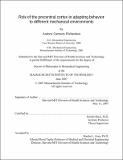| dc.contributor.advisor | Emilio Bizzi. | en_US |
| dc.contributor.author | Richardson, Andrew Garmory, 1977- | en_US |
| dc.contributor.other | Harvard University--MIT Division of Health Sciences and Technology. | en_US |
| dc.date.accessioned | 2007-11-15T21:35:01Z | |
| dc.date.available | 2007-11-15T21:35:01Z | |
| dc.date.copyright | 2007 | en_US |
| dc.date.issued | 2007 | en_US |
| dc.identifier.uri | http://hdl.handle.net/1721.1/39485 | |
| dc.description | Thesis (Ph. D.)--Harvard-MIT Division of Health Sciences and Technology, 2007. | en_US |
| dc.description | This electronic version was submitted by the student author. The certified thesis is available in the Institute Archives and Special Collections. | en_US |
| dc.description | Includes bibliographical references (p. 155-171). | en_US |
| dc.description.abstract | We routinely produce movements under different mechanical contexts. All interactions with the physical environment, such as swinging a hammer or lifting a carton of milk, alter the forces experienced during movement. With repeated experience, sensorimotor maps are adapted to maintain a high level of movement performance regardless of the mechanical environment. This dissertation explored the contribution of the precentral cortex to this process of motor adaptation. In the first experiment, we recorded precentral neural activity in rhesus monkeys that were trained to perform visually-cued reaching movements while holding on to a robotic manipulandum capable of changing the forces experienced during the task. Preparation and control of the reaching movements were correlated with single cell activity throughout the precentral cortex, including the primary motor cortex and five different premotor areas. Precentral field potential activity was also modulated during the reaching behavior, particularly in the beta and high gamma frequency bands. When novel forces were introduced, single cell activity changed in a manner that specifically compensated for the applied forces and mirrored the time course of behavioral adaptation. | en_US |
| dc.description.abstract | (cont.) Force-related changes were present in the field potential activity as well. Some of these changes were maintained following removal of the forces. Control data and simulations revealed that these residual changes were well described by a model of noisy adaptation in a redundant cortical network. In the second experiment, human subjects performed the same reaching paradigm after receiving transcranial magnetic stimulation to transiently inhibit cortical activity. Initial learning of the novel force environment was normal but recall of the field 24 hours later was impaired relative to controls. Taken together, the results suggest that distributed areas within the precentral cortex are involved in recalibrating sensorimotor maps to fit the present mechanical context and in initiating a memory trace of newly-experienced environments. | en_US |
| dc.description.statementofresponsibility | by Andrew Garmory Richardson. | en_US |
| dc.format.extent | 171 p. | en_US |
| dc.language.iso | eng | en_US |
| dc.publisher | Massachusetts Institute of Technology | en_US |
| dc.rights | M.I.T. theses are protected by copyright. They may be viewed from this source for any purpose, but reproduction or distribution in any format is prohibited without written permission. See provided URL for inquiries about permission. | en_US |
| dc.rights.uri | http://dspace.mit.edu/handle/1721.1/7582 | |
| dc.subject | Harvard University--MIT Division of Health Sciences and Technology. | en_US |
| dc.title | Role of the precentral cortex in adapting behavior to different mechanical environments | en_US |
| dc.type | Thesis | en_US |
| dc.description.degree | Ph.D. | en_US |
| dc.contributor.department | Harvard University--MIT Division of Health Sciences and Technology | |
| dc.identifier.oclc | 174277803 | en_US |
